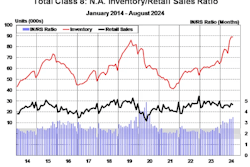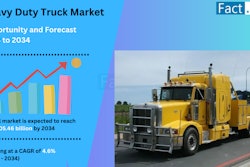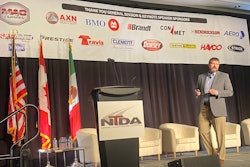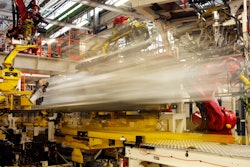
The state of the economy ranked as the trucking industry's top concern this year, according to American Transportation Research Institute's (ATRI) 20th annual Top Industry Issues report, but Monday at the American Trucking Associations Management Conference and Exhibition in Nashville, ATA’s Chief Economist Bob Costello said things are looking up.
Trucking has been battered by over-capacity and low rates and volume since the end of the pandemic, and Costello said he even feels "snake bitten" for expecting a return that never seems to come. "We haven't seen normal since the pre-pandemic," he said. "Every cycle is different, this one included."
The general economy continues to slow but Costello said the probability of a recession remains low and that many main drivers of truck freight won't get worse "and in some cases, even get a little better."
Costello forecast that manufacturing output in the chemical, primary metals, computers, electronic equipment, appliances and transportation equipment sectors would climb at least 2% next year, with the computer segment jumping 6%.
Consumer spending
Consumers have been spending on experiences and services post-pandemic at the expense of goods, but Costello said data already shows that returning to normal. Housing activity has been tough thanks to interest rates hikes enacted to tamp down record inflation, but the Fed has already started to cut rates and will continue to decrease interest rates at a modest pace, Costello said, adding that those positive effects won't be immediate.
"It takes a long time for decreases to work their way through the economy," he said.
The tight job market is loosening, too. This year, 200,000 jobs are added on average every month, and the U.S. just went through the longest period of sub-4% of unemployment since the 1960s. Costello said there is about one job for every unemployed person, giving the Fed confidence to continue to drop interest rates. A 30-year fixed mortgage is already down a percentage point, "and will continue to come down," Costello said, "but it's not going to come down as much or as fast as the Fed Funds rate," and a return to 3% interest on a 30 year home loan is not on the horizon.
Costello expects better homes sales in 2025 and single-family housing starts to flatten. Non-residential construction, he said, would continue to grow, but at a slower overall pace.
Wage growth has moderated but will remain near historical averages, Costello said, adding real wages after inflation are going up at or above historical averages, "and that means more people have money in their pockets to buy goods."
The liquidity of that money could be an issue, though. Household credit card debt, for the first time ever, has surpassed $1 trillion. This could be a headwind for people's ability to spend their money, Costello said, adding that while it is a concern, delinquency rates are up but are not close to Great Recession levels, and with regard to total household debt of disposable household income, "we're at pretty low levels."
Inflation is down to 2.4%, "back to where we need to be," Costello said, but consumers' buying power remains a problem. While inflation rates are indeed coming down, prices for goods are not. Since 2020, prices overall are up 22%.
The trucking recession was sparked by consumer spending that focused on travel and experiences versus goods coming out of the pandemic, but the service industry is currently bearing much of the burden of elevated prices and those prices are expected to continue to climb while prices on durable goods have already started to fall. Consumers that once sought to take trips or go out with their money are finding it a better investment to stay home and invest those funds in goods, which moves more freight.
"Let's go ahead and buy something," Costello said. "Remember, we haven't bought goods in a while."
On average, the U.S. economy grows at about 2% annually Costello said, but 60% of that growth figure comes from services where trucking doesn't have a stake.
Factory and industrial manufacturing, retail and construction are primary drivers of freight. Costello noted falling factory output this year, adding he expects it to grow a little more than 1% next year. "I know that doesn't sound great, but historically it's pretty close to normal," he said. "I'm not telling you it's going to boom, but it's going to get a little bit better."
Sluggish recovery
Transportation has been expecting a recovery quarter-by-quarter that is nearly a year overdue thanks to a variety of factors. During the COVID boom private fleets expanded, taking some of the freight off the fi-hire market that isn't coming back.
For-hire carriers have been slow to leave the industry despite the tough business climate but, oddly enough, Costello said, an actual freight recovery is likely to accelerate carrier exits.
Loan extensions granted by equipment lenders have kept capacity in the market, but if the market improves, used truck evaluations improve and freight improves, more fleets will go out of business, he said, because lenders will want to accelerate payments and claw back that deferred money quickly. "I don't know when you just get a little bit of growth that those fleets would be able to do that," he said.
The digitization of freight has also helped carriers on the margins quickly find freight and allowed them to get paid quicker, creating cashflow that's helped sustain them, even if it's with a negative operating margin. "Eventually," Costello said, "it's going to run out."
While it may not feel like it, Costello said supply has been coming down. "We just haven't felt it yet because demand hasn't picked up enough," he said. It's a painful reality, but "more companies need to fail," he added.
About 34,000 carriers with operating authority have left the market since December 2022 (about 9%), but Costello theorized many of those simply latched on with another carrier. Indeed capacity exits have been slow, but he said there is no doubt that supply and demand are leaking slowly toward equilibrium.
Over-capacity has helped relieve a driver shortage problem that's long been a burden of trucking companies. "It obviously has gotten better, but it's gotten better for all the wrong reasons. It's gotten better because freight demand has slowed," Costello said. "If things pick up a little bit more than I expect, we would start to see the driver shortage rear its ugly head again."
Under pressure
The truckload contract market is seeing improvement. It's down against a tough comparison, "but it's moving in the right direction," Costello said. The spot market hasn't recovered but the rate of decline has slowed. LTL shipments and tonnage have been in decline since 2022, and while Costello said he was "bullish" on an LTL recovery, he added it would be slower.
The industry is feeling the squeeze in a few directions: market pressures and cost pressures, "A bad place to be," Costello said.
Market pressures include a falling revenue per mile that's down about 13% on contracts and down almost 30% in spot. Cost pressures include driver earnings that have never been higher and trucking costs that have reached record highs in each of the last three years. Costello said that costs have gone up 35% but revenue is up only 16%.
"We do have indications that at least parts of the truck freight are improving," he said.
Political climate
The U.S. is just weeks away from one of the most volatile presidential elections in recent memory, but both candidates have a common ground: Near-shoring. "Trade policy the only thing they agree on," Costello said.
Mexico is seeing tremendous manufacturing growth, and 70% of the volume between the Mexico and US go via truck. "I don't like tariffs, but it has created an environment where Mexico is doing quite well and a lot of that is coming north bound," Costello said. "Presidents take way too much credit and way too much blame for the economy."











